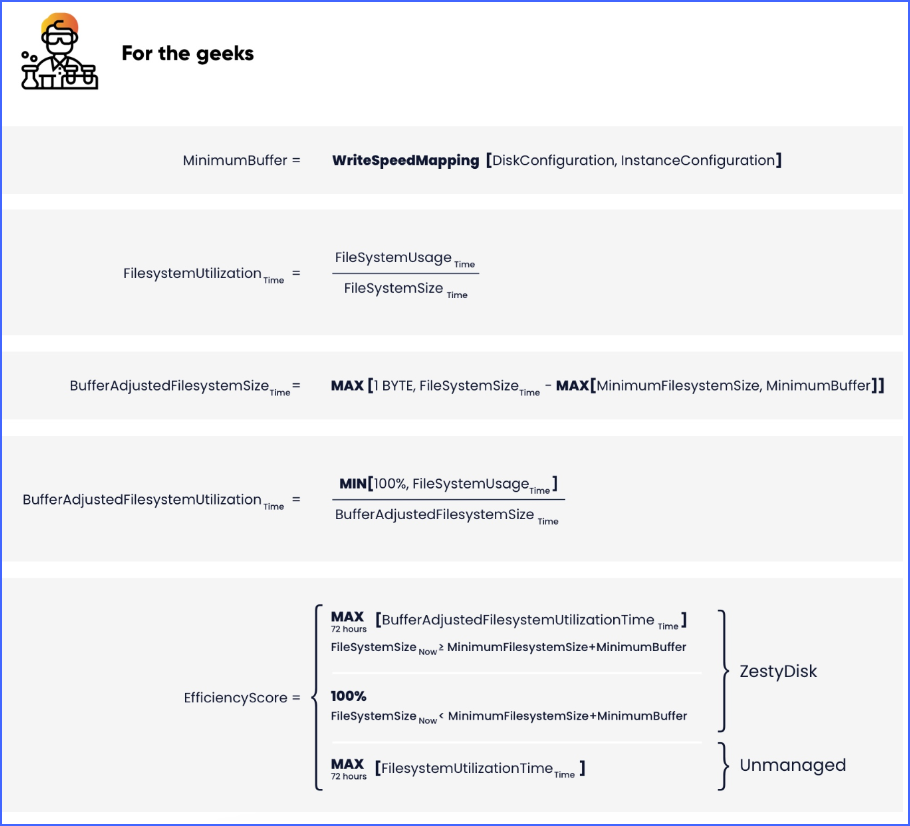The filesystem efficiency score is the filesystem utilization including the extra capacity required for Zesty Disk management. The percentage is the highest of the past 72 hours, where 100% is perfect.
When it comes to rightsizing filesystem space, there is a tradeoff between getting extra space in advance (larger filesystem) and getting the exact size we need at that specific moment (minimal filesystem).
This tradeoff is described in the following table:
Larger filesystem | Minimal filesystem | |
|---|---|---|
System stability | The system can withstand a surge in usage. | The system is very sensitive to usage surges. |
Cost | You pay for excess resources. | You pay only for resources that are actually used. |
Zesty Disk real-time autoscaling solves this conflict in the most efficient way, allocating the smallest size filesystem that can withstand the greatest usage surge, based on your usage patterns.
The efficiency score also takes into account the physical properties of the instance and disk devices used, which dictates the speed at which filesystem usage can increase in a worst case scenario and how fast Zesty can scale the filesystem size.
How is the filesystem efficiency score calculated?
When determining how efficient a filesystem is, the following variables are taken into consideration:
Disk configuration: The type and number of volumes that are in the Zesty Disk filesystem.
Instance configuration: The type of instances running Zesty Disk.
Minimum buffer: The minimum free filesystem space required for the automatic scale management, determined as the larger of the Zesty Disk-calculated amount or the customer-defined buffer.
Write speed mapping function: Generally, both the volume’s configuration and instance configuration influence how fast we can read and write from a filesystem. Having a greater number of volumes that work at a faster speed as well as larger and faster instances will generally enable faster writes. Zesty developed a proprietary mapping technology that tells us how fast data can be written based on the system. We use this to determine the minimum buffer needed for a particular configuration.
Filesystem usage: The amount of storage used on a filesystem at any given time.
Filesystem size: The total size (in GB) available on a filesystem at any given time.
Buffer-adjusted filesystem size: This is the filesystem size, reduced by the largest minimum size we can have for any filesystem and the minimum buffer.
Filesystem utilization: The percentage of the filesystem used at any given time.
Buffer-adjusted filesystem utilization: The percentage of the buffer-adjusted filesystem used at any given time.
The efficiency score is determined as follows:
For Zesty Disk filesystems: The maximum buffer-adjusted filesystem utilization over the past 72 hours, which reflects both the choice of minimum buffer used by Zesty’s proprietary Write Speed Mapping Function and Zesty Disk’s ability to dynamically provision size as efficiently as possible. Filesystems that are so small that they cannot be decreased without risking data loss are assigned an efficiency score of 100%.
For filesystems not managed by Zesty Disk: The maximum Filesystem Utilization over the past 72 hours.
Because manual provisioning decisions never take into account the short-term bursts that can happen at any moment, but rather the long term needs, a minimum buffer is not included in the calculation.
The following volumes are assigned an automatic 100% score:
New volumes: Volumes created within the last 3 days. After 3 days, sufficient metrics can be generated.
Minimum size volumes: When a volume’s total size is less than or equal to the user-specified minimum size.
Ephemeral volumes: When ephemeral volumes are the only volumes in a Zesty Disk filesystem.
